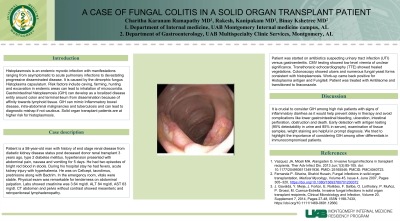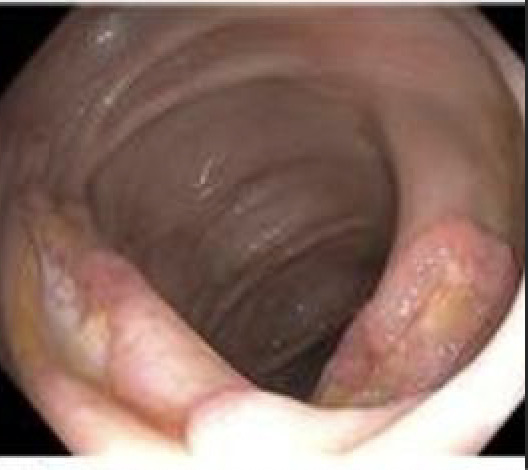Sunday Poster Session
Category: IBD
P0994 - A Case of Fungal Colitis in a Solid Organ Transplant Patient
Sunday, October 27, 2024
3:30 PM - 7:00 PM ET
Location: Exhibit Hall E

Has Audio
- CK
Charitha Karanam Ramapathy, MBBS
Baptist Medical Center South
Montgomery, AL
Presenting Author(s)
Award: Presidential Poster Award
Charitha Karanam Ramapathy, MBBS, Rakesh Kanipakam, MD, Binay Kshetree, MD
Baptist Medical Center South, Montgomery, AL
Introduction: Histoplasmosis is an endemic mycotic infection with manifestations ranging from asymptomatic to acute pulmonary infections to devastating progressive disseminated disease. It is caused by the dimorphic fungus Histoplasma capsulatum. Risk factors include caving, farming, hunting and excavation in endemic areas can lead to inhalation of microconidia. Gastrointestinal histoplasmosis (GIH) can develop as a localized disease entity around colon and terminal ileum from dissemination because of affinity towards lymphoid tissue. GIH can mimick Inflammatory bowel disease, intra-abdominal malignancies and tuberculosis and can lead to diagnostic mishap if not cautious. Solid organ transplant patients are at higher risk for histoplasmosis.
Case Description/Methods: Patient is a 58-year-old man with history of end stage renal disease from diabetic kidney disease status post deceased donor renal transplant 3 years ago, type 2 diabetes mellitus, hypertension presented with abdominal pain, nausea and vomiting for 5 days. He had two episodes of bright red blood in stools. During his hospital stay he had fevers, acute kidney injury with hyperkalemia. He was on cellcept, tacrolimus, prednisone along with Bactrim. In the emergency room, vitals were stable. Physical exam was remarkable for tenderness on abdominal palpation. Labs showed creatinine was 3.64 mg/dl. ALT 84 mg/dl, AST 63 mg/dl. CT abdomen and pelvis without contrast showed mesenteric and retroperitoneal lymphadenopathy. Patient was started on antibiotics suspecting urinary tract infection (UTI) versus gastroenteritis. CMV testing showed low level viremia of unclear significance. Transthoracic echocardiography (TTE) showed healed vegetations. Colonoscopy showed ulcers and numerous fungal yeast forms consistent with histoplasmosis. Work-up came back positive for Histoplasma antigen and Fungitell. Patient was treated with AmBisome and transitioned to Itraconazole.
Discussion: It is crucial to consider GIH among high risk patients with signs of inflammatory diarrhea as it would help prevent delay in therapy and avoid complications like lower gastrointestinal bleeding, ulceration, intestinal perforation, obstruction and death. Early detection with antigen testing (95% detectability in urine and 85% in serum), examination of tissue samples, wright staining are helpful in prompt diagnosis. We tried to highlight the importance of considering GIH among other differentials in immunocompromised patients.

Disclosures:
Charitha Karanam Ramapathy, MBBS, Rakesh Kanipakam, MD, Binay Kshetree, MD. P0994 - A Case of Fungal Colitis in a Solid Organ Transplant Patient, ACG 2024 Annual Scientific Meeting Abstracts. Philadelphia, PA: American College of Gastroenterology.
Charitha Karanam Ramapathy, MBBS, Rakesh Kanipakam, MD, Binay Kshetree, MD
Baptist Medical Center South, Montgomery, AL
Introduction: Histoplasmosis is an endemic mycotic infection with manifestations ranging from asymptomatic to acute pulmonary infections to devastating progressive disseminated disease. It is caused by the dimorphic fungus Histoplasma capsulatum. Risk factors include caving, farming, hunting and excavation in endemic areas can lead to inhalation of microconidia. Gastrointestinal histoplasmosis (GIH) can develop as a localized disease entity around colon and terminal ileum from dissemination because of affinity towards lymphoid tissue. GIH can mimick Inflammatory bowel disease, intra-abdominal malignancies and tuberculosis and can lead to diagnostic mishap if not cautious. Solid organ transplant patients are at higher risk for histoplasmosis.
Case Description/Methods: Patient is a 58-year-old man with history of end stage renal disease from diabetic kidney disease status post deceased donor renal transplant 3 years ago, type 2 diabetes mellitus, hypertension presented with abdominal pain, nausea and vomiting for 5 days. He had two episodes of bright red blood in stools. During his hospital stay he had fevers, acute kidney injury with hyperkalemia. He was on cellcept, tacrolimus, prednisone along with Bactrim. In the emergency room, vitals were stable. Physical exam was remarkable for tenderness on abdominal palpation. Labs showed creatinine was 3.64 mg/dl. ALT 84 mg/dl, AST 63 mg/dl. CT abdomen and pelvis without contrast showed mesenteric and retroperitoneal lymphadenopathy. Patient was started on antibiotics suspecting urinary tract infection (UTI) versus gastroenteritis. CMV testing showed low level viremia of unclear significance. Transthoracic echocardiography (TTE) showed healed vegetations. Colonoscopy showed ulcers and numerous fungal yeast forms consistent with histoplasmosis. Work-up came back positive for Histoplasma antigen and Fungitell. Patient was treated with AmBisome and transitioned to Itraconazole.
Discussion: It is crucial to consider GIH among high risk patients with signs of inflammatory diarrhea as it would help prevent delay in therapy and avoid complications like lower gastrointestinal bleeding, ulceration, intestinal perforation, obstruction and death. Early detection with antigen testing (95% detectability in urine and 85% in serum), examination of tissue samples, wright staining are helpful in prompt diagnosis. We tried to highlight the importance of considering GIH among other differentials in immunocompromised patients.

Figure: Colonoscopy showing signs of colitis with ulcers.
Disclosures:
Charitha Karanam Ramapathy indicated no relevant financial relationships.
Rakesh Kanipakam indicated no relevant financial relationships.
Binay Kshetree indicated no relevant financial relationships.
Charitha Karanam Ramapathy, MBBS, Rakesh Kanipakam, MD, Binay Kshetree, MD. P0994 - A Case of Fungal Colitis in a Solid Organ Transplant Patient, ACG 2024 Annual Scientific Meeting Abstracts. Philadelphia, PA: American College of Gastroenterology.

